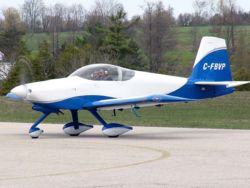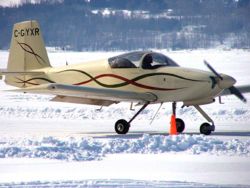PlaneSpottingWorld welcomes all new members! Please gives your ideas at the Terminal.
Van's Aircraft RV-9
The Van's RV-9 and RV-9A are two-seat, single-engine, low-wing homebuilt airplanes sold in kit form by Van's Aircraft. The RV-9 is the tail-wheel equipped version while the RV-9A features a nose-wheel. The RV-9 is a development of the RV-6 and RV-7 and is externally similar to both those designs.
Contents
Development
The architect of the line of Van’s aircraft, Richard VanGrunsven, designed the RV-9 as a departure from the concepts of the earlier RV series. The earlier members of the RV series, starting with the single seat RV-3, were all designed to have light handling, aerobatic capabilities along with fast cruise speeds and short field STOL capabilities. The RV-9 was designed from the start as a two-place, side-by-side, touring aircraft and as such it forgoes the aerobatic capabilities and the lighter handling for more stability and economy. As such the design horsepower is 118-160 and the prototype was flown with a Lycoming O-235 powerplant of 118 hp as a proof-of-concept for the lower horsepower.
As a result of the lessons learned over the years in producing the first five RV-series designs and the change in role for this aircraft, the RV-9 design incorporated many changes over previous designs. Compared to the similar RV-7, the RV-9 has a wing of increased span and higher aspect ratio using a Roncz airfoil. The RV-9 has a slow stall speed, comparable to the Cessna 150, and docile handling suitable for low-time pilots. The cruise speed is a very respectable 167 mph TAS even with the 118 hp engine.
The RV-9 shares many common parts with the RV-7 and the RV-8 which reduces production costs. Like those aircraft, the RV-9 uses computer assisted design to produce a kit with pre-drilled rivet holes, thus greatly reducing assembly time for the builder.
The RV-9 is unique in Van’s aircraft history in that the tricycle gear RV-9A version was flown first on June 15, 2000, three years before the tail wheel version flew. The later conventional landing gear equipped RV-9 was first flown by its designer in 2002. The RV-9A features tubular steel landing gear with the nosewheel mounting tube welded to the engine mount. As in all nose-wheel equipped RV aircraft, the nosewheel is free castering and the aircraft is steered with differential braking. The brakes are mounted conventionally on the rudder pedal toes.
Aircraft Type Club
The RV-9 and RV-9A have a very active aircraft type club Van's Air Force that provides support for owners and pilots of these aircraft.
Specifications (RV-9A)
Specifications are given for 118 hp, O-235 configuration with a fixed pitch propeller
General characteristics
- Crew: one pilot
- Capacity: one passenger
- Length: 20 ft 5 in (6.28 m)
- Wingspan: 28 ft 0 in (8.62 m)
- Height: 6 ft 0 in (1.85 m)
- Wing area: 124 ft² (11.5 m²)
- Empty weight: 1057 lb (478 kg)
- Loaded weight: 1,600 lb (724 kg)
- Max takeoff weight: 1,600lb (724kg)
- Powerplant: 1× Lycoming O-235 or Lycoming O-320 fixed pitch, 118-160hp (88-119 kW)
Performance
- Never exceed speed: mph (km/h)
- Maximum speed: 173 mph at sea level (280 km/h)
- Range: 875 statute miles at cruise 75% power at 8,000 ft (1,418 km at cruise 75% power at 2,500 m)
- Service ceiling: 14,500 ft (4,400 m)
- Rate of climb: 1,000 ft/min (5.1 m/s)
- Wing loading: 12.9 lb/ft² (65 kg/m²)
Related content
Related development
Similar aircraft
Designation series
RV-3 - RV-4 - RV-6 - RV-7 - RV-8 - RV-9 - RV-10 - RV-11 - RV-12
External links
References
Lists relating to aviation | |
|---|---|
| General | Timeline of aviation · Aircraft · Aircraft manufacturers · Aircraft engines · Aircraft engine manufacturers · Airports · Airlines |
| Military | Air forces · Aircraft weapons · Missiles · Unmanned aerial vehicles (UAVs) · Experimental aircraft |
| Notable incidents and accidents | Military aviation · Airliners · General aviation · Famous aviation-related deaths |
| Records | Flight airspeed record · Flight distance record · Flight altitude record · Flight endurance record · Most produced aircraft |


